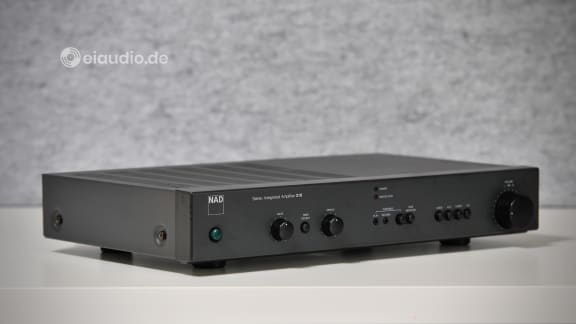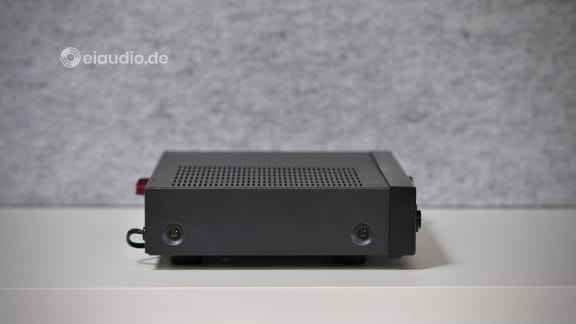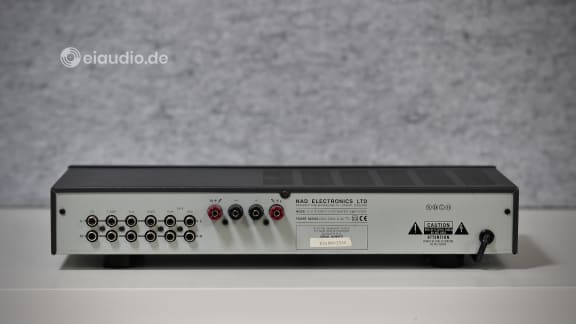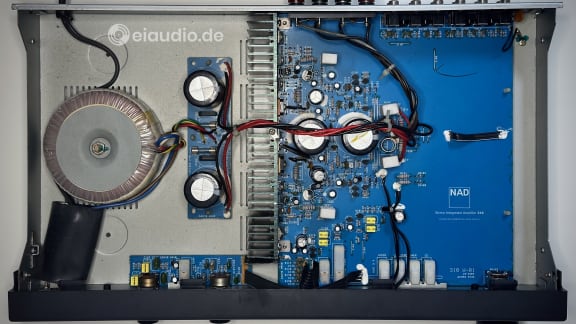NAD 310
Published: 08/08/2024
Manufacturing date: 1994
Author: Karsten Hein
Category: Gear & Review
Tag(s): Integrated Amplifiers
In summer 2024, Michael and Iris contacted me to say they were contemplating spending their holidays at the German North Sea. I very much welcomed the idea of seeing them again and could not wait to give Micheal a tour of our new studio. As our two guest rooms were already occupied at the time, my wife, Sabina, offered to help them find suitable accommodation near us. Michael, a fellow audiophile, who had previously lent me his wonderful Teufel M200 loudspeakers for exploration, informed me that he would be bringing along a smallish NAD 310 amplifier for testing this time. And, although I had always felt a little put off by NAD’s over-marketed audiophile-on-a-budget claim, I was happy to hear that Michael was once again offering to show me something new.
The last time I had heard an NAD system play music was during a visit to my former English lecturer Martin von Schilling’s apartment in Bayreuth. And, although some 25 years had gone by since then, I still remembered the sonic signature of the system to be very true to music. Of course, the material we listened to in those days was quite different from the calm Jazz and classical performances I tend to play today. In fact, I have fond memories of Martin racing my Audi 80 up the A3 towards Frankfurt with G&R "Mr. Brownstone" blasting on my custom car stereo. Therefore, I could not be certain how much of my positive impression of Martin von Schilling’s home stereo system had been due to my lack of experience at the time.
When Michael and Iris arrived at the North Sea, Sabina, our kids, and I spent the first evening with them at the levee in Friedrichskoog listening to live Rock & Pop music performed by some local cover band. The musicians had to brave heavy gusts of wind, and their PA system seemed to be compensating for this circumstance with excessive volume. Having refreshed our impression of live music, we spent the rest of the evening at a local restaurant, talking about music, our recent move from Frankfurt to the North Sea, and other family affairs. The need for additional space for our family, for our language school, but also for Explorations in Audio had been among the important factors in our decision to seek our fortune away from the banking metropolis.
In our new studio in Marne, I could, for the first time, show Michael three permanent HiFi setups in a designated listening space that was outside the living quarters of our family. Within this, each loudspeaker had been set up to allow for near-linear sound reproduction in relation to the specific characteristics of the room and the listening position. There were few parallel walls, and the furnishings had been chosen to reduce reverberation times. The available space behind each system allowed for easy installation and faultless wiring. It was the kind of playing field that most audiophiles can only dream of for their hobby, and it provided the basis for my assessments of the sound quality of HiFi components.
At the time of Michael’s visit, my reference system consisted of a Thorens TD320 turntable (with AT VM95 ML cartridge and Audiophonics linear power supply), a Marantz CD-17 CD player (complete with Ken Ishiwata-styled output stage), a much heralded Symphonic Line RG9 MK3 integrated amplifier, and Martin Logan SL-3 electrostatic loudspeakers. The cables were Symphonic Line Harmonie HD interconnects (from CD) and Belden 9497 speaker cables set up in Y-bi-wiring from a single point of contact on the amp to the separate high and low terminals of the loudspeakers. A Symphonic Line power cord and a dedicated power installation—a straight line leading to the central fuse box of our house—assured the availability of clean electricity in abundance.
Although the NAD 310 could (at least in theory) have driven my Martin Logan speakers, given its extensive high feedback handling abilities, both the electrostatic panels and the dynamic woofers of the Logan’s hybrid design demanded for a higher wattage power amplifier and would have been an unfair match for the NAD’s modest 20 watts RMS per channel. My Tannoy XT8f loudspeakers, however, which were part of the adjacent system, were relatively easy to drive at 8 Ohms and a high sensitivity of 91 decibel. And it was this system that we connected the NAD 310 to.
The frontend consisted of a Pioneer PD-S705 CD player which once was famous for its platter drive mechanism and inverted disc placement. As the NAD 310 does not feature an integrated phono stage, we simply accepted the fact and did not make any attempts to connect a turntable via an external phono stage. The cables were Stager Silver Solid Core interconnects from CD and Symphonic Line Harmonie HD cables in single wiring to the speakers. We used 4mm-thick solid core copper wire jumpers to connect the Tannoy’s high and low frequency drivers. The speakers themselves were positioned on their bare spikes, which firmly held the Tannoys in place on top of immovable 38kg stone slabs. This infrastructure was surely not the typical environment for the affordable NAD 310 to perform in and therefore promised to be interesting.
Anzeige eiaudio/shop:
Michael and I began our listening session with a live performance of the German Tom Waits cover band “Bad As We” that was recorded straight onto an analogue reel-to-reel tape machine by the former Bavarian public radio sound engineer Andreas Sandreuther and the Nürnberg analog-treff founder, Heinz-Peter Völkel. Live||Tape is the name of their new (strictly analogue) label, and even when re-mastered for CD, the dynamic range and bare bones realism of the original recording are impressive. Michael and I had previously listened to the CD performed on large pre and amplifier combos and were surprised to find that, with the NAD 310, much of the original drive, tonality, and dimension remained the unchanged. This realization was especially perplexing considering the NAD’s modest size, weight, and tiny circuit boards.
There is something about hearing a performance first hand that is difficult to transport in a written report. And I confess that very little we could have read about the NAD would have prepared us for the event. With our eyes closed and at normal listening volumes, we would have easily mistaken the sound of the NAD 310 for that of a pre and amplifier combo, and a very good one at that. In direct comparison to my Restek V1 and Echle LF-3519 setup, the NAD was less forceful, occasionally lacking some of the bite of the piano notes. However, on many recordings this proved to be a good thing rather than a liability. Despite losing some of the discerning edges of a music event, the NAD 310 managed to maintain excellent tonality and homogeneity and propagated a decidedly non-fatiguing and highly musical sound.
Vocals were rendered with natural detail and recognisable timbre, and the sound stage showed similar width and depths as I was used to from my separate components. In direct comparison to the Restek V1 and Echle LF-3519 setup, however, the NAD 310 provided less space around each instrument, making each sonic event seem closer to the next in terms of time and space. This became especially clear when we listened to Helge Lien’s album “No. 10”, which superbly plays with the listener’s sense of space. Having listened to Singer-Songwriter and Jazz music with me for a while, Michael asked me, if I also had some electronic music at hand.
I first thought of some iteration of a Boris Blank album, but then I remembered that I had just stumbled upon a 1993 Culture Beat album sitting on one of the free take-away shelves along the streets in Husum. For both of us, it had been years since we last listened to a Torsten Fenslau production, and we had to smile at the improbability of this idea. Michael remembered that, on the album “serenity”, track number three “got to get it” with vocals by Tania Evans used to be quite popular. We cranked up the volume and were transported back to the dry German Disco beats of the 90s. The NAD 310 managed to handle the increase in volume very well and, to our surprise, did not seem at all strained or compressed. The Tannoy’s high sensitivity and 6dB bass accentuation probably played a part in this solid performance.
Being greatly pleased with our listening test of the NAD 310, Michael and I decided to end our session by taking the Culture Beat CD over to my Martin Logan reference system (with RG9 MK3 amplifier), thinking that we would pretty much hear more of the same music. To my relief, however, this was not the case. The Martin Logans made each sample come alive with such width, depth and sparkle that the previous performance seemed somewhat pale and lifeless in comparison. There was so much detail and dimension that even the crude Culture Beat disco album started to make sense to me now. I think Michael and I were both a little surprised by this transformation, because there really had been nothing “wrong” with the system we had listened to before. On the contrary, it had delivered an excellent performance that left very little to want for at the time.
The NAD 310 is a budget amplifier that punches well above its weight and employs some clever design choices to perform this trick. Rachel Cramond wrote an extensive review about this phenomenon for Gramophone magazine in 2012. (They let you read it a few times before erecting a pay wall). Next to the cost saving reduction of electronic parts by approximately 50%, the NAD 310 features a pure class A driver stage and a carefully matched combination of MosFET and bipolar transistors. One difference to conventional A/B amplifiers can be seen in the two large capacitors found to the right of the heat sink (see photo) on the amplifier board in addition to the power supply caps that are located next to the toroidal transformer.
The secondary capacitors assure that there is always plenty of dynamic headroom, even when the amplifier is driven near maximum volume. There are limitations in terms of slew rate and signal damping that cannot be denied on a 20 watts amplifier. It is therefore best matched with responsive electronics at the front and sensitive speakers at the back. My choice of unshielded silver cables and the Tannoy speakers worked very well in this respect.
Although the NAD 310 had been in Michael’s possession for some years already, he had never heard it perform in such a dedicated listening environment and meticulous setup and therefore was quite surprised by how much of the performance depended on the periphery. And I had never heard a piece of equipment in this affordable price bracket that could so well hold its own in such an environment. I am certainly going to look at NAD’s rather flimsy looking amplifier designs with more respect now. I can promise you this: under normal household conditions, any restrictions in musical fidelity heard in conjunction with the NAD 310 are most likely caused by how it is matched with the periphery and not by the amplifier itself.
Specifications
Power Amplifier
- Type: Integrated solid state stereo amplifier
- Transformer: 100 VA, toroidal
- Power consumption (max.): 92 Watts
- Output power (RMS, 8 Ohms): 2x 20 Watts
- Output power (RMS, 4 Ohms): 2x 30 Watts
- Output power (RMS, 2 Ohms): 2x 40 Watts
- High current stability: < 2 Ohms
- Frequency response (+0.3dB): 20 - 20,000 Hz
- Frequency response (+/-3dB): 10 - 70,000 Hz
- Harmonic distortion (@25 Watts, 8 Ohms): <0.05%
- Signal-to-noise ratio: 100 dB
- Input sensitivity (rated power @ 8 Ohms): 1V
- Signal damping (50 Hz): >100
- Slew rate: >20 V/usec
Preamplifier
- Phono section: not available
- Line inputs: CD, Video, Tuner, Tape, Auxiliary
- Input impedance: 80 kOhms + 220 pF
- Input sensitivity: 210 mV
- Input signal (max.): >10 V
- Signal to noise ratio (1 Watt): 93 dB
- Signal to noise ratio (power max.): 106 dB
- Infrasonic filter: -3 dB at 10 Hz (12 dB per octave)
- Treble attenuation: +/- 7 dB at 10 kHz
- Bass attenuation: +/-6 dB at 50 Hz
- Tone attenuation defeat: yes
General
- Country of Manufacture: Taiwan R.O.C.
- Dimensions: (W) 435mm x (H) 65mm x (D) 250mm
- Weight: 5 kg
- Year(s): 1995







